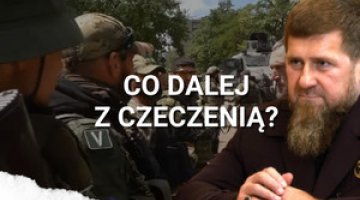An air defence coalition for Ukraine. Day 638 of the war

Deteriorating weather conditions on the front have limited both sides’ offensive operations, but at the local level they are nevertheless still making attempts to break through their opponents’ defences. Russian forces have made further advances in the south-eastern part of Avdiivka, and have now taken over most of the industrial area there. On the left bank of the Dnieper, Ukrainian troops once again pushed back the invaders south of the part of Krynky which the defenders control. By contrast, the Ukrainians’ attacks south of Orikhiv and north-west of Horlivka, and by the Russians in the areas of Marinka, Bakhmut and Kupyansk, have not brought about any significant changes. The Ukrainian General Staff have drawn attention to the continued relatively high number of Russian attempts to attack the defenders’ positions: 30 hostile assaults were said to have taken place in the area of Avdiivka on 22 November.
Before noon on 24 November, local Ukrainian sources reported explosions in Mykolaiv. Earlier, the Ukrainian Air Force Command had warned that the Russians were using ballistic missiles in the area, and reported the use of two Kh-59 missiles and three Shahed-136/131 kamikaze drones (all the drones were shot down). During the night, the invaders again struck Starokostiantyniv in Khmelnytskyi oblast (probably its military airfield), after having attacked it previously on 22 November (the local authorities reported three waves of kamikaze drones). On 23 November, hostile missiles struck the Voznesensk area of Mykolaiv oblast, as well as Kryvyi Rih a day earlier, when a critical infrastructure facility was hit. On 22 November, Russian kamikaze drones furthermore attacked in Kyiv and Zhytomyr oblasts: according to the Air Force Command, all 14 Shaheds used by the invaders were neutralised. On the evening of 21 November, a Russian Kh-22 cruise missile hit one area of Zaporizhzhia city, from where it was reported that the shockwave damaged 31 buildings. In turn, the Russians used Kh-31P missiles to attack air defence installations in Odesa oblast and at Bilhorod-Dnistrovskyi. According to a communiqué from the Ukrainian General Staff, a total of 10 cruise and ballistic missiles were used by the invaders on 21–23 November.
On 24 November, the Russians reported another Ukrainian attack on Crimea and the destruction of all 13 kamikaze drones used in it. There were reports of explosions near a military unit in the town of Dzhankoi. Once again, a military unit in the village of Kotluban in the Volgograd oblast was also the target of a Ukrainian attack (the Russians reported that three kamikaze drones had been shot down; the previous attack, which started a fire, took place on 16 November). On 22 November, the Strategic Communications Board of the Ukrainian Armed Forces confirmed that on 19 November defenders carried out an attack on a group of servicemen of the 810th Guards Naval Infantry Brigade of the Russian Black Sea Fleet in the occupied part of Donetsk oblast. It occurred during a concert to celebrate Russian Artillerymen’s Day. Several people (including one of the performing artists) were killed and dozens injured; according to some Ukrainian accounts, 25 Russians were killed and 100 wounded. The attack was said to be in revenge for the strike on Ukrainian soldiers during a ceremony marking Rocket Forces and Artillery Day, which is celebrated in Ukraine on 3 November.
On 22 November, the 17th meeting of the Ramstein format contact group of countries offering Ukraine military support was held remotely. Pentagon chief Lloyd Austin reported that since the beginning of the full-scale Russian invasion, 50 countries have provided Kyiv with military support currently totalling more than $80 billion. He stressed that Ukraine’s partners are now placing their main emphasis on boosting its air defence capabilities so that it will be able to repel expected strikes by Russia on its energy infrastructure this winter. Summing up the meeting, President Volodymyr Zelensky and defence ministry chief Rustem Umierov announced that 20 countries supporting Ukraine had formed a coalition to expand the ground component of Ukraine’s air defence, with Germany and France leading the coalition. Umierov also announced that the Netherlands had set aside €2 billion for further military aid to Ukraine. The Canadian government pledged 1.3 billion Canadian dollars (US$947 million) until 2026; this will include C$816 million in 2023–4, C$318 million in 2024–5 and C$197 million in 2025–6. The Lithuanian defence ministry announced another military support package, including 3 million rounds of 7.62×51-mm ammunition. The Bulgarian Parliament approved an inter-ministerial agreement, originally concluded in August, to transfer to the Ukrainian defence ministry equipment and spare parts (including wheeled armoured personnel carriers) which had previously been withdrawn from service in the Bulgarian interior ministry.
On 21 November the German defence minister Boris Pistorius, who was visiting Kyiv, announced that his country’s new €1.3 billion military support package would consist of four IRIS-T air defence systems, 20,000 155-mm artillery munitions and anti-tank mines; he did not specify when these would arrive in Ukraine. He also announced that Germany plans to transfer 140,000 155-mm shells to Ukraine in 2024. Asked about Germany’s delivery of Taurus cruise missiles to Ukraine, he said he had no new information on the subject. A day later, the German defence ministry announced the transfer of another package of military support, including 20 Marder 1A3 infantry fighting vehicles, one WiSENT armoured recovery vehicle, two HX81 tractors with trailers, and 2380 rounds of 155-mm ammunition.
On 21 November, the EU’s Internal Market Commissioner Thierry Breton reported that by spring 2024 the production capacity of arms companies within the EU (located in 15 countries) will reach one million artillery ammunition units per year, rising to 1.3–1.4 million rounds by the end of next year. At the same time, he pointed out that one reason for the problems in meeting ammunition supply commitments for Ukraine is that European manufacturers are still continuing their exports to third countries, and these account for 40% of their total production. On the same day Mykhailo Fedorov, Ukraine’s deputy prime minister and minister for digital transformation, reported that around 200 enterprises in Ukraine are now involved in producing drones. The production level has already reached thousands, and in his words, “even tens of thousands in certain categories”. The Ukrainian state supports the development of local production, but much of the components for it must still be imported.
On 21 November, Ukrainian Air Force spokesman Yuri Ihnat confirmed that Ukrainian pilots on F-16 fighter jets and the ground personnel to service them are being trained in Denmark under the supervision of local instructors, and their independent flights will begin once the training has been completed.
On 21 November Oleksandr Kyrylenko, deputy chief of the Ukrainian General Staff, reported that as of February 2022 more than 100,000 Ukrainian troops had already completed various kinds of training on the territory of 32 partner countries. The current system focuses on four priorities: (1) the basic training of recruits, who must be prepared to fulfil combat tasks within 35 days; (2) training in the use of Western models of weapons and military equipment, and the specialised preparation of doctors, sappers, snipers and operators of anti-tank systems; (3) the training of platoon, company and battalion commanders; (4) the collective training of units of different levels and commands in offensive and assault operations.
On 24 November, the Ukrainian defence ministry revealed the size of its budget in 2024. It will amount to 1.164 trillion hryvnias ($32.2 billion), of which 862 billion hryvnias ($23.9 billion) will cover the costs of the soldiers’ salaries, uniform and food. The sum of 265.4 billion hryvnias ($7.3 billion) will cover the purchase of weapons, drones and ammunition, as well as the overhaul of equipment damaged during hostilities. Priority will be given to the acquisition of missile systems: some 175 billion hryvnias (more than $4.8 billion) have been set aside from the total sum for this purpose. 36 billion hryvnias (about $1 billion) have been earmarked for the reconstruction of the Armed Forces’ infrastructure.
On 22 November Oleksiy Danilov, the secretary of Ukraine’s National Security and Defence Council, indicated that Russian forces had changed their war tactics from short-term to long-term measures, with the aim of the ultimate destruction of Ukraine. Vladimir Putin’s new plan is based on undermining the three factors determining the strength of Ukraine’s resistance: the internal unity of the Ukrainian public, the support of the West, and the motivation of the Ukrainian army. The Russians are also conducting an extensive disinformation operation to create an artificial conflict between Ukraine’s military and government. On the same day Oleksandr Lytvynenko, the head of the Foreign Intelligence Service, indicated that Russia’s war with Ukraine had entered a critical period and that the conflict would continue for a long time. In his words, the volume of military production in the Russian Federation in 2026 will still be able to support large-scale combat operations, and by 2028 the country’s army will regain the capabilities it had in 2022. Lytvynenko warned that Russia is also preparing for future aggression against Moldova and the Baltic states, and will also work to fuel conflicts in the Middle East, Africa and the Balkans. He stressed that, in the case of Ukraine, Putin wants to implement a plan to “return those lands which were originally Russian”, and the key to Russian victory is to trigger the internal destabilisation of Ukraine and get the financial and military aid from the West to be suspended, which Putin assumes will lead to the start of peace negotiations on the Kremlin’s terms.
On 23 November, Ukrainian local authorities announced that forced passportisation was continuing in the occupied areas of Zaporizhzhia and Kherson oblast. Men who have received a Russian document are required to register with a military commission. From 1 January, the Russians will designate all residents of the occupied territories who have not received such passports as ‘foreigners’.
Commentary
- The US’s problems in agreeing further funding for military aid to Ukraine mean that European countries, primarily Germany, have now begun to demonstrate readiness to adopt a position of leadership. German minister Pistorius’ visit to Kyiv (the day after Lloyd Austin and General Christopher Cavoli went there) and his announcement of a new €1.3 billion military aid package (on 20 November, the Americans announced another $100 million support package) should be seen in this context. However, it should be remembered that this includes equipment that realistically will only be delivered to Ukraine within the next few months, or even over a year. This mainly concerns the air defence systems that Kyiv already needs, which German industry is not in a position to produce quickly.
- A comparison of the series of military aid packages announced by Washington and Berlin, on average every fortnight, confirms that despite the current problems in continuing to fund this support, it is the Americans who are still providing more armaments and munitions (including surface-to-air missiles) than the EU does as a whole. Moreover, a large proportion of the German packages consists of non-military equipment. At the same time, however, American aid is currently less than it was just a few months ago, and the government in Kyiv has made no secret of its disappointment with this situation. President Zelensky’s declaration that the newly-established air defence coalition was headed by Germany and France can be seen as a kind of attempt to shift the main burden of responsibility for helping Ukraine onto Europe.






